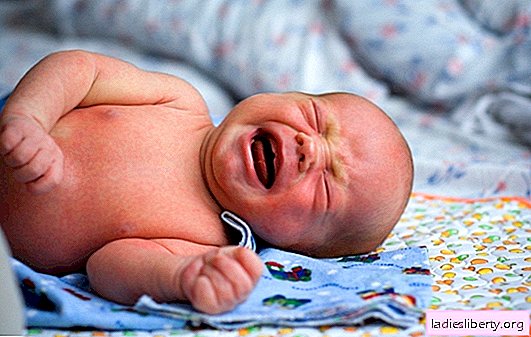
Normal microflora of the human intestine includes lactobacilli, bifidobacteria, E. coli in certain quantitative proportions. In addition, it includes conditionally pathogenic microflora: Proteus, enterococci, staphylococci. Disruption of microflora, both qualitative and quantitative, leads to dysbiosis - a pathological condition that requires correction. Under the influence of external influences harmful to the body, intestinal disorders occur. In case of dysbiosis, the cause may be the increased activity of conditionally pathogenic microorganisms, which exhibit their pathogenic properties when the amount exceeds the normal microflora.
Dysbacteriosis is not a disease, such a diagnosis does not exist in the ICD (International Classification of Diseases). This is a pathological condition, a syndrome indicating a violation of the microflora as a result of any reasons.
Dysbacteriosis in a newborn - causes
If dysbacteriosis develops in a newborn, its reasons can be various:
- pregnancy pathology;
- early breastfeeding;
- improper nutrition;
- Uncontrolled use of drugs by a nursing mother;
- environmental degradation.
These are common, often found, combining many nuances, causes of dysbiosis in a newborn.
1. The nutrition of the infant is one of the important points that must be adhered to accurately and scrupulously. The cause of dysbiosis in a newborn can be:
- early feeding;
- increased consumption by a nursing mother of carbohydrates and animal fats;
- congenital malformations of the digestive system in the newborn,
- diseases of the stomach and intestines;
- Infectious diseases (dysentery, salmonellosis).
2. The use of drugs by both the nursing mother and the child: a long reception, and sometimes a normal length of the course of antibiotics, leads to the death of microorganisms of the normal intestinal flora along with pathogenic microflora, which leads to dysbiosis in the newborn. The reasons for the development of dysbiosis in these cases are an overdose or disruption in taking the drugs.
3. Ecology is not the last in the list of causes of the development of dysbiosis in the newborn. Studies show that in infants living near large enterprises, dysbiosis develops much more often than in newborns developing in favorable environmental conditions.
4. All of the above leads to a decrease in immunity - also an important factor in the development of dysbiosis in a child. Reduced immunity leads to infections, which often have to be treated with antibiotics.
5. Postpartum injuries, diabetes mellitus, other diseases can be an impetus to development and one of its causes.
6. Stress - frequent quarrels and screams in the family, when the child cries and gets nervous - can lead to the development of dysbiosis in the newborn. The causes and mechanisms of the development of dysbiosis as a result of stress are well understood. Parents need to remember this and keep calm and calm in the house where the child lives.
Dysbacteriosis in a newborn - symptoms
With the development of dysbiosis, the pathogenic flora actively multiplies and prevails over the normal intestinal microflora. As a result of such a violation, dysbiosis in the newborn develops, its symptoms are as follows:
1. Intestinal colic: an hour and a half after eating, the child has abdominal pain, which is manifested by anxiety, crying, pulling legs to the stomach, insomnia, and there is practically no weight gain.
2. Frequent stool, in feces - impurities of curled lumps, a lot of gases go off during bowel movements.
3. Flatulence, as one of the symptoms of dysbacteriosis in a newborn, is manifested by bloating, regurgitation.
4. Change the color of feces to yellow - green.
5. Rashes on the skin, thrush in the oral cavity.
6. With severe dysbiosis in a newborn, symptoms, in addition to the above, include fever and sharp abdominal pain that occurs after eating, accompanied by nausea and vomiting.
Dysbacteriosis in a newborn whose symptoms have been listed can occur not only in the intestine. It can affect the skin, oral mucosa, external auditory canal, umbilical wound.
The stages of dysbiosis in the newborn and their clinical manifestations
The development of dysbiosis in a newborn includes four stages, each of which is manifested by certain symptoms:
Stage 1: minor disturbances in the microflora, can be asymptomatic, diagnosis is difficult.
Stage 2 (borderline): the amount of normal microflora is slightly reduced, and the amount of pathogenic is increased uncritically and cannot disrupt the intestines, taking live lactobacilli and bifidobacteria will be effective and will prevent further development.
Stage 3: a significant decrease in normal intestinal microflora; The clinic of intestinal dysbiosis in the newborn is expanded.
Stage 4: the beneficial intestinal microflora is significantly reduced and the amount of pathogenic flora is increased, which is manifested by a vivid clinical picture, severe damage to the digestive system, up to sepsis.
Depending on the stage of development of dysbiosis in the newborn, its symptoms also increase. There are three degrees of clinical manifestations in a newborn with dysbiosis:
1 degree -
decreased appetite, flatulence, a tendency to constipation, decreased stool color, poor weight gain;
2 degree -
abdominal pain, signs of intoxication (fever, nausea, vomiting, headaches), anemia, hypovitaminosis are added to the above symptoms;
3 degree -
intoxication increases up to sepsis (bacteria enter the bloodstream through the intestinal wall and spread throughout the body), secondary immunodeficiency develops.
Dysbacteriosis in a newborn - treatment
With a prolonged course of dysbiosis in a newborn whose treatment was not prescribed on time, or whose reasons cannot be eliminated due to some circumstances, a chronic form develops. At the same time, in addition to the intestine, other organs and systems are involved in the pathological process, which can lead to irreversible consequences. Therefore, it is so important to recognize dysbacteriosis in a newborn in time, the treatment of which should begin immediately.
It is important to remember that the treatment of dysbiosis in a newborn should be carried out exclusively for the purposes and under the supervision of a pediatrician. In no case should you independently treat a child and use drugs without a doctor’s prescription.
With dysbiosis in the newborn treatment includes the following required steps:
- proper nutrition;
- normalization of disturbed intestinal microflora;
- elimination of toxins from the intestine;
- intake of enzymes, if there are signs of digestive disorders;
- the fight against flatulence with the help of sorbents and normalization of nutrition;
- vitamin therapy;
- increase immunity.
In most cases, the intestinal microflora in newborns with dysbacteriosis is restored independently by eliminating the causes of dysbacteriosis and treating the underlying disease that caused the disturbance of normal flora.
The following drugs are used in the treatment of dysbiosis in a newborn:
1. Sorbents - drugs that cleanse the body of toxic substances.
2. Bacteriophages - destroy pathogenic microorganisms.
3. Prebiotics - stimulate the growth of normal microflora.
4. Probiotics - live bacterial cultures.
5. Antibiotics and antimicrobials are prescribed only for severe intestinal infections, are used strictly according to the scheme.
Dysbacteriosis in the newborn - prevention
Dysbacteriosis in a newborn is easier to prevent than to treat long and expensive in the future. The development of dysbiosis in a newborn, the prevention of which includes certain measures, can be prevented by the following actions:
- early attachment to the chest;
- breastfeeding;
- the mandatory introduction of fermented milk mixtures with mixed feeding;
- walks, hardening procedures;
- personal hygiene.
When the first alarming symptoms appear, you must immediately consult a doctor, without wasting time or doing any independent treatment - and success will be ensured.











